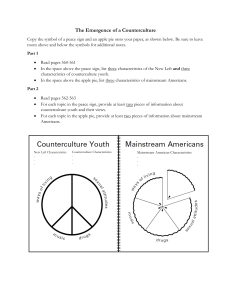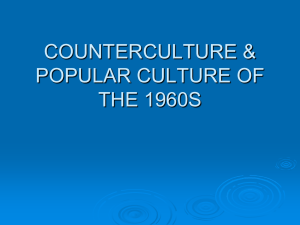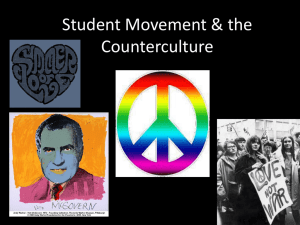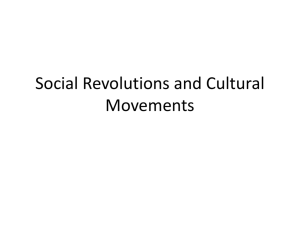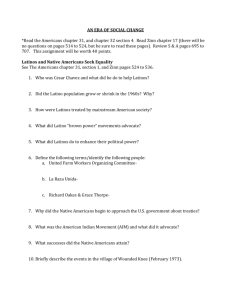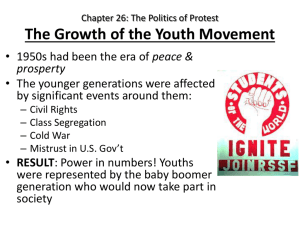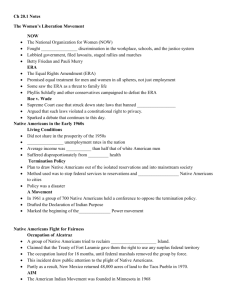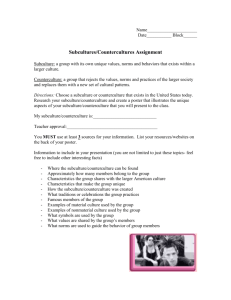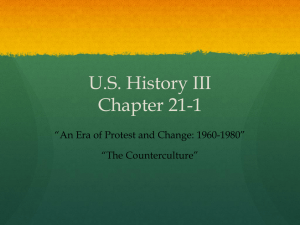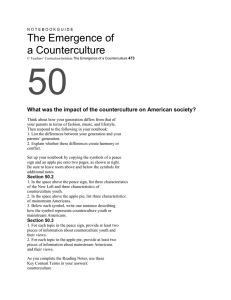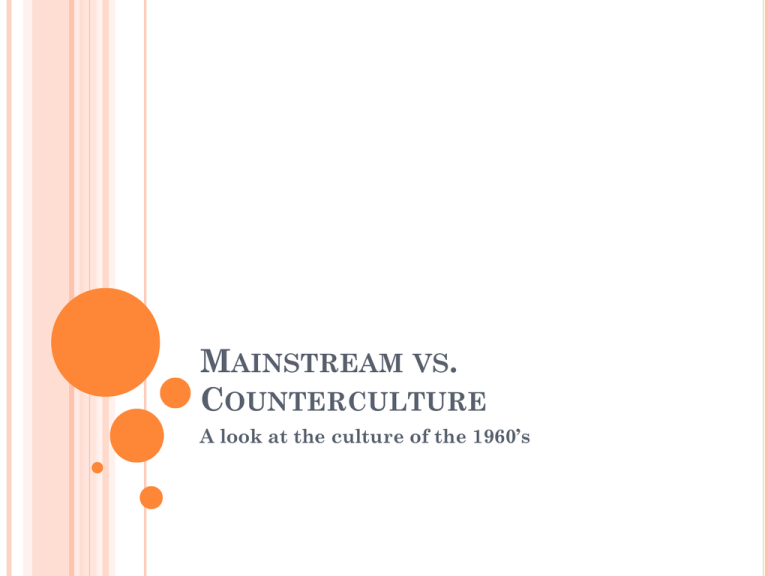
MAINSTREAM VS.
COUNTERCULTURE
A look at the culture of the 1960’s
PREVIEW
What are the key differences between your
parents’ generation?
Do differences help create harmony or conflict?
1960’S HISTORICAL CONTEXT
Political, social, and cultural strife
Vietnam protests
Civil Rights protests, demonstrations, riots
Assassinations of John F. Kennedy, Robert Kennedy,
and Martin Luther King, Jr.
Counterculture led mostly by youths challenged
traditional thinking held by the mainstream culture
Many envisioned a world based on individual
expression, freedom from tradition, love, community,
sex, drugs, and rock and roll
Some spoke avidly against the Vietnam War
RESISTANCE TO COUNTERCULTURE
A time where jobs, money, job, and responsibility
were less important than the spirit of love,
togetherness, and harmony with nature
They argue that the political activism of the
1960s led to societal changes
Counterculture had a negative influence on
American society
The movement opened the floodgates to a
permissive society where drug use and sexual
disease is rampant and where belief in
traditional values is scorned
FIVE
TOPICS WILL BE DEBATED…..
Fashion
Communal Living
Political activism
Music
Drugs
Overall question: Were the effects of the
counterculture on American society positive or
negative?
INSTRUCTIONS
You will be in groups of four: two will represent
the mainstream while the other two
counterculture
You will be provided prompts to promote your
discussion
Mainstream will go first by repeating the
statement and then a discussion
You will have two minutes to discuss
Counterculture will repeat the same process with
their opening statement
INSTRUCTIONS CONTINUED….
Be respectful of each other
Disagreement is expected but don’t be critical of a
person
Don’t take criticims of your ideas as a personal
attack
Listen to each other even if you don’t agree
Change your mind when there is supporting
evidence
Try to understand both sides of the debate
CONSENSUS
Once both positions have been presented (at the
end)
Generate an consensus report on the original
question: Were the effects of the counterculture
on American society positive or negative?
STRUCTURED CONTROVERSY
Structured controversy can enhance the development of many skills
that are central to academic learning. These skills include:
searching for information and new experiences to resolve a dilemma
or an uncertainty;
organizing information;
preparing an advocacy position and rationalizing the position;
seeing issues from a different perspective and learning to debate the
merits of each position; and
synthesizing issues and conceptualizing a new position or reaching
consensus based on careful analysis and evaluation of all positions of
the issue.
By using structured controversy, students' curiosity for searching for
solutions to the problem will be sparked, engaging them in active
learning that will help develop their understanding and appreciation
of diverse points of views. It also requires students to use complex
reasoning and critical thinking skills. As a result, students are
exposed to a greater range of ideas that will help them to generate
creative solutions and new conclusions to their controversial problem
. http://iteslj.org/Techniques/Zainuddin-Controversial.html
PEDAGOGICAL IMPLICATIONS
How might a structured controversy be useful in
a social studies classroom?
What are the benefits of this method?
Are there any potential drawbacks?
Why is the consensus aspect of debating essential
and key in understanding issues?
How might you pair students?

